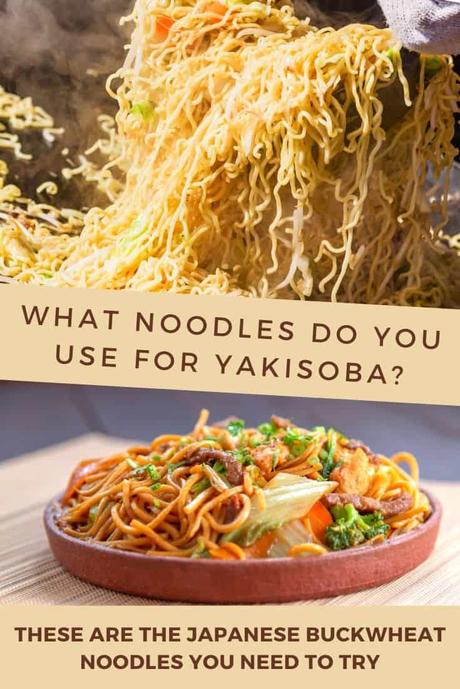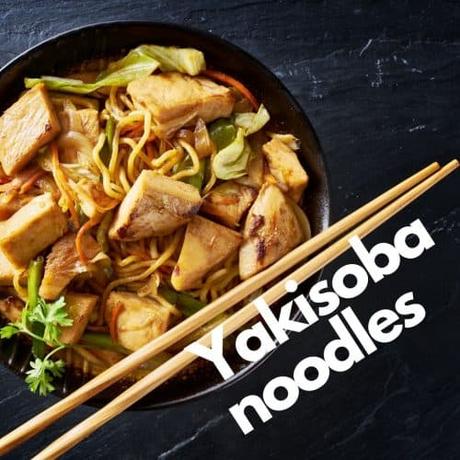The Yakisoba dish has gotten many people curious to try cooking it at home.
In this post, I’ll talk about the question my readers have asked me a lot, and I decided to answer it in an in-depth guide to Yakisoba.
What noodles do you use for Yakisoba?

Yakisoba, the classic Japanese dish, usually uses buckwheat noodles as its main ingredient. In fact, “soba” in Yakisoba means buckwheat noodles. You also need a special Yakisoba sauce and other ingredients to make it.
I’ll address the next questions you might have as well, like what to add to your dish and how to make a recipe.
But before you start experimenting with your Japanese meal, let’s get a better understanding of the dish first.
What is Yakisoba?
Yakisoba is a Japanese noodle dish stir-fried with meat and vegetables. Almost any kind of meat can go well in yakisoba:
- beef
- chicken
- pork
- shrimp
- and even fish fillet.
The meat is usually chopped or thinly sliced for faster cooking.
Vegetables that are mostly used in the dish include:
- carrots
- cabbages
- capsicums
- mushrooms
- and paprika.
People love Yakisoba because it is rich in flavor, thanks to the various ingredients and the unique taste of Japanese soy sauce.
Yakisoba leaves a huge room for creativity and personal preference as you can decide what ingredients to put in.
The next best thing about Yakisoba is that you can cook it in abundance and store the leftovers.
Put it in the fridge or freezer and reheat it when you want to serve it again. A lot of families in Japan make twice at much Yakisoba as the family’s portion for one dinner.
They reheat the leftovers the next morning and pack it in a bento box for their lunch.
Yakisoba can either be nutritious or not, depending on how you make the portion.
Too little vegetables and meat means a bigger percentage of noodles, which might give you excess carbohydrates.
Try balancing your meal with more meat and veggies.
Yakisoba noodles
The word “soba” means buckwheat noodles, which are commonly used in Yakisoba.
However, it is also common to use regular wheat noodles like the one in ramen. People sometimes use egg noodles as well.
Soba noodles are actually one of the most popular of all of these kinds of noodles we’ve written about before, so it’s no wonder why Yakisoba is so well liked.
There are many plain soba noodles in packs, especially if you live in Japan. The popular brands include
- Sun Noodle
- Hakubaku
- and Roland
Some of these noodles are dried, so you need to boil them first and strain them. There are also soba noodles that are already soft and wet.
You just need to pour it with hot water to loosen it up.
Outside Japan, it might be a little difficult to find instant Yakisoba noodles in the supermarket.
But it is not a huge deal because there are many other options you can use as a substitute.
Whole wheat vermicelli or Chinese wheat noodles can be a close alternative. You can also try udon or spaghetti instead.
That’s just not ideal though.
Yakisoba sauce
Yakisoba has a unique base taste that comes from the Yakisoba sauce. Many people love making their sauces from scratch because it is pretty easy.
But due to the popularity of the dish, many companies provide ready-to-use Yakisoba sauce.
Some popular brands are
- Kikkoman
- Otafuku
- and Hichifuku
If you want to cook Yakisoba at home but never eat Yakisoba before, you can use this instant sauce first to know the actual taste of Yakisoba.
And then, you can start experimenting with your recipes.
Instant Yakisoba
If using Yakisoba sauce is still too much of an effort for you, there is another quicker option. It is the Yakisoba instant noodles.
Similar to Asian instant noodles, the packet contains the noodle and the seasoning as well.
All you need to do is just boil the noodles for three minutes, strain them, and mix them with the seasonings provided in the package.
Some popular brands are Nissin, Maruchan, and Myojo.
Although they are easy and tasty, instant noodles are rather unhealthy as they contain preservatives and artificial ingredients.
Not to mention the lack of vegetables and protein, although some brands are already fortified.
However, you can always make a healthier version of instant yakisoba noodles by adding fresh vegetables and proteins when cooking it.
The History of Yakisoba
Yakisoba has its roots from the Chinese Chow Mein, the stir-fried wheat vermicelli seasoned with salt and Chinese soy sauce.
Japanese made their version of chow mein using Japanese traditional sauces. The dish started happening around the 1950s, after World War II.
At that time, flour was rather expensive, so they started mixing it with cabbage, which is much cheaper and abundant.
Yakisoba went popular real quick. People love the taste, even the children. Many snack stalls started putting Yakisoba on their menu.
People then tried getting creative and made a lot of variations of Yakisoba. Up until today, this dish is still one of the prima donnas in the Japanese culinary arts.
You can find this dish at restaurants, food stalls, or even the temporary booths in festivals.

Yakisoba beef and cabbage recipe
There are no such things as exact recipes for Yakisoba because the ingredients can vary from one cook to another. But the one thing that gives the unique taste of Yakisoba is the Japanese soy sauce, so make sure you don't miss this one. Here is one example of Yakisoba Recipe: Course Main CourseCuisine JapaneseKeyword Buckwheat, Noodles Prep Time 10 minutesCook Time 20 minutesTotal Time 30 minutes Servings 4 people Author Joost Nusselder Cost $15Ingredients
- 1 tbsp soy sauce
- 1 tbsp oyster sauce
- 1½ tsp Worcestershire sauce
- 1 tsp sugar
- 1 pack of soba noodles
- 4 ounces of beef slices
- 2½ ounces of cabbages thinly-sliced
- 1 medium carrot julienned
- 6 pcs shiitake mushrooms thinly sliced
- 2 whole scallions julienned
- Olive oil for pan-searing
Instructions
- Make the Yakisoba sauce by mixing the soy sauce, oyster sauce, Worcestershire sauce, and sugar. Set aside.
- Saute the beef slices until they turn brownish. Set aside.
- Open the pack of soba. Pour boiling water to the soba and lose them with a chopstick. Drain the soba and set them aside.
- Take another wok and start stir-frying the mushrooms for about two minutes.
- Add in other vegetables and keep stirring for another two minutes
- Add in the sauteed beef, the noodles, and the Yakisoba sauce.
- Continue the stir fry until they all mixed evenly and cooked thoroughly.
- Yakisoba is ready to serve
Here’s Just One Cookbook with their recipe:
You can serve Yakisoba on a plate. But some fancy restaurants will use a hotplate instead to keep it stays piping hot for a longer time.
On top of the dish, you can sprinkle a little bit of aonori (green seaweed flakes), katsuobushi (bonito flakes) or benishōuga (pickled red ginger).
Versions of Yakisoba
As mentioned before, there are many versions of Yakisoba you can try throughout the country. Here are some of the most notable ones:
Sosu YakisobaIt is the mainstream style of Yakisoba, where the noodles are seasoned with Worcestershire sauce and oyster sauce.
The color is a bit brownish due to the sauces.
Shio Yakisoba
This is the Yakisoba with a lighter flavor as it does not use any brown sauce as seasonings.
The noodles are mainly flavored with salt and light sauces. This version of Yakisoba is the most similar to Chinese Chow Mein.
Kata Yakisoba
Also known as “hard Yakisoba”, the cooking of this dish started by deep-frying the plain yakisoba until it turns hard. The hard soba is then topped with vegetables and meat
Ankake Yakisoba
This version of Yakisoba has translucent thick starchy sauce instead of served dry like regular Yakisoba. People mostly use seafood instead of meat for this dish.
Yokote Yakisoba
Originally from the Akita Prefecture, Yokote Yakisoba uses thick and straight noodles as its main ingredients. The dish will include a soft-cooked sunny-side egg at the top of the serving.
Fujinomiya Yakisoba
This variety comes from Shizuoka Prefecture. Fujinomiya Yakisoba uses local noodles with a chewy texture, deep-fried intestines, and local dashi broth powder. Even the cabbages are from local farms.
More Creations
Even the ready-to-eat Yakisoba dish can be processed further to make a whole new dish. Here are some food creations made from Yakisoba:
Yakisoba-pan
It is a hot dog bun stuffed with Yakisoba. The word “pan” means bread in Japanese.
Yakisoba-pan is another practical way to bring your noodles as an easy lunch. To make this dish, you need to make sure your Yakisoba is dry, or else your bread will turn soggy.
Modan-yaki
It is a style of Okonomiyaki from Osaka. Yakisoba is put on top of the Okonomiyaki dough while being grilled.
And then, you flip it so the Yakisoba layer gets grilled as well. The meats and veggies of the Yakisoba are what give the okonomiyaki a rich savory flavor.
Omusoba
It is a Yakisoba dish wrapped in a fluffy omelet roll and topped with tonkatsu sauce and mayo.
Omusoba is great for reusing leftover Yakisoba as it gives added protein and warmth. Omusoba is one of the most popular comfort foods in cold weather.
Sobameshi
It is a mixture of stir-fried rice and soba, along with the vegetables and meats. The dish is originally from the Kobe City of Hyogo Prefecture.
Nowadays, sobameshi is available in frozen packs where you can find them in almost every supermarket in the country.
The taste of Yakisoba is irresistible, especially if you know how nutritious it can be. But what makes the food hit it off in Japan is its convenience.
It is easy to make and it leaves a lot of room for you to get creative. Even if you are not a fan of cooking, you can always find many variations of Yakisoba to taste.
